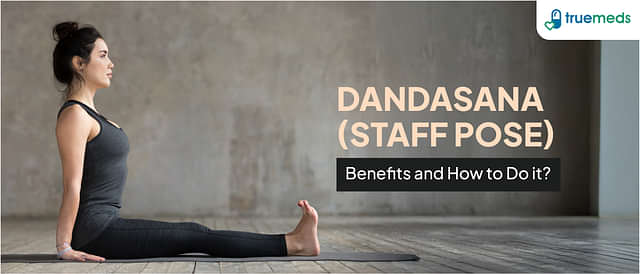Yoga for Diabetes: 10 Essential Poses for Diabetes Management
Last updated on : 30 Nov, 2025
Read time : 14 min
Diabetes Mellitus is a chronic, multifactorial metabolic disorder that requires integrated management, including prescribed medication, dietary modification, and regular physical activity [1]. While poor diet and lack of consistent physical exercise are known contributors to the progression of Type 2 Diabetes, research suggests that yoga offers a practical, holistic approach to physical activity. Regular practice can be effective at reducing psychological and physiological stress, which is a significant factor influencing blood sugar control through the release of counter-regulatory hormones like cortisol [2]. Research supports the role of regular yoga practice in potentially enhancing insulin sensitivity and improving overall metabolic function [3].
This article discusses the evidence-based benefits of yoga for people with diabetes and outlines specific postures often recommended to support optimal glucose control and improve quality of life. Yoga is a complementary approach and should not replace prescribed medical treatment.
How Yoga Supports Diabetes Management
Yoga, or Hatha Yoga, involves the union of mind, body, and spirit through physical postures (asanas) and breathing techniques (pranayama). Its benefits, particularly for chronic illness management, are generally attributed to [4]:
- Improving Insulin Sensitivity: Physical activity and muscle engagement, particularly in certain stretching and weight-bearing poses, can enhance the glucose uptake of muscle cells, making them more responsive to insulin [5].
- Reducing Stress Hormones: Yoga activates the parasympathetic nervous system (rest-and-digest), which helps lower the circulating levels of stress hormones (cortisol and adrenaline). These hormones typically increase blood sugar levels, making stress reduction crucial for glycemic control [2].
- Enhancing Circulation: Poses and breathing techniques can improve blood flow, which is crucial for preventing or managing diabetes-related vascular complications, such as neuropathy and retinopathy.
10 Essential Yoga Asanas for Diabetes Support
The following yoga postures are often incorporated into routines for individuals managing diabetes. Studies have indicated that asanas that involve deep stretching, forward bending, and twisting may particularly benefit abdominal organ function and promote deep relaxation [4].
1. Kapal Bhati Pranayama (Skull-Shining Breathing Technique)
How it helps with Diabetes?
This technique involves forceful, short exhalations followed by passive inhalations. While primarily a breathing exercise, it is thought to stimulate the autonomic nervous system and has been shown in some studies to significantly reduce fasting and post-meal blood glucose levels, alongside its known benefit of stress reduction [6].
How to Perform Kapal Bhati?
There are eight steps to do Kapal Bhati:
- Sit comfortably with your spine erect. Place your hands on the knees with palms facing the sky.
- Take a deep breath in.
- As you begin to exhale, pull the navel sharply back towards your spine. This exhalation should be short and forceful.
- Place your right hand on the stomach to feel the contractions of the abdominal muscle.
- As you relax the abdomen, the breath flows back into the lungs (passive inhalation).
- Repeat the breath exercise twenty (20) to thirty (30) times, and this makes up one cycle.
- After completing one round, close your eyes and relax. Feel the sensations in the body for a while.
- Do two more such cycles, resting between each.
2. Supta Matsyendrasana (Supine Spinal Twist)
How it helps with Diabetes?
This pose is a gentle twist that massages the abdominal region, which may theoretically aid in stimulating the organs involved in digestion and glucose regulation. Its primary proven benefit is deep relaxation and a reduction in lower back tension.
How to perform Supta Matsyendrasana?
There are seven steps to do Supta Matsyendrasana:
- Lie flat on your back with arms stretched sideways in a ‘T’ position.
- Extend the left leg; bend the right knee and hug it to the chest.
- Gently cross the right knee over to the left side, keeping the right shoulder grounded.
- Turn your head to the right, away from the knee.
- Ensure both shoulders remain grounded.
- Hold the pose and breathe deeply for 30 seconds to 1 minute.
- Return to the centre and repeat on the other side.
3. Dhanurasana (Bow Pose)
How it helps with Diabetes?
The Bow Pose creates intense compression in the abdomen. This is hypothesized to stimulate the pancreas, though direct scientific evidence is limited. It is reliably known to strengthen the back and abdominal muscles and is an excellent stress and fatigue buster [4].
How to perform Dhanurasana?
There are seven steps to do Dhanurasana:
- Lie on your stomach with your feet apart and arms by the side of your body.
- Fold your knees, take your hands backward, and hold your ankles.
- Breath in and, lift the chest off the ground and pull your legs up and towards the back.
- Look straight ahead with a relaxed expression.
- Maintain a stable pose, focusing on your breath. Your body is curved as a bow now.
- Keep taking long and deep breaths. Bend only within a comfortable range; do not overdo the stretch.
- After 15-20 seconds, gently bring your legs and chest to the ground as you exhale. Release the ankles and relax.
4. Paschimottasana (Seated Forward Bend)
How does Paschimottasana help with diabetes?
This deep forward bend gently compresses and massages the abdominal and pelvic organs, which may aid in toning the digestive and endocrine systems. It is highly effective for calming the nervous system, thereby reducing stress-related blood sugar fluctuations [7].
How to perform Paschimottasana?
There are eight steps to do Paschimottasana:
- Sit up with the legs stretched out straight in front of you, keeping the spine erect and toes flexed towards you.
- While breathing in, raise both arms above the head and stretch.
- Breathing out, bend forward from the hip joints, moving your chin towards the toes, keeping the spine as straight as possible. Focus on hinging from the hips, not rounding the back.
- Place your hands on the legs as far as they can reach without strain. If possible, take hold of your toes.
- Breathing in, lift your head slightly and lengthen your spine.
- Breathing out, gently deepen the fold.
- Hold the pose and breathe deeply for 30 to 60 seconds.
- To exit, stretch out the arms in front of you. With the strength of the arms, breathing in, return to the sitting position. Breathe out and lower the arms.
5. Ardha Matsyendrasana (Half Spinal Twist)
How does Ardha Matsyendrasana help with diabetes?
This sitting half spinal twist applies pressure to the abdominal organs, which is traditionally linked to improving metabolic function. It is documented to calm the mind and improve blood flow to the spinal cord and nervous system, contributing to lower stress.
How to perform Ardha Matsyendrasana?
There are steps to do Ardha Matsyendrasana:
- Sit with legs stretched out straight in front of you, keeping the feet together and the spine erect.
- Bend the left leg and place the heel of the left foot beside the right hip.
- Take the right leg over the left knee, placing the foot flat on the floor.
- Place the left hand on the right knee and the right hand behind you (as a kickstand).
- Twist the waist, shoulders, and neck in the same sequence to the right and look over the right shoulder.
- Keep the spine erect.
- Hold and continue with long gentle breaths in and out for 30 seconds.
- Breathing out, release the right hand first, then the waist, the chest, and lastly the neck.
- Repeat on the other side.
- Come back to the front and relax.
6. Shavasana (Corpse Pose)
How Shavasana helps with diabetes?
It is the final, essential yoga pose. Shavasana is arguably the most important for blood sugar control as its sole purpose is to induce deep physical and mental relaxation. By allowing the nervous system to fully enter the parasympathetic state, it minimizes the output of glucose-raising stress hormones [2].
How to perform Shavasana?
There are eight steps to do Shavasana:
- Lie flat on your back without support, preferably. Close your eyes.
- Keep the legs comfortable and apart. Let your feet and knees relax completely, and your toes face the sides.
- Place your arms on the side, a little away from your body. Keep your palms open and face the sky.
- Divert the attention to various body parts, consciously relaxing each one.
- Begin with awareness in the right foot, then move on to the right knee, and slowly move towards your head.
- Keep breathing slowly. The goal is to remain awake and alert but completely still and relaxed.
- After 10-20 minutes, slowly roll onto your right side, keeping your eyes closed. Lie in that position for a few moments. Then, taking the support of the right hand, gently sit up into a seated pose.
- Keep your eyes closed and take a few deep breaths in and out as you gradually become aware of your environment and the body. When you are ready, slowly and gently open your eyes.
7. Legs-Up-the-Wall Pose (Viparita Karani)
How Legs-Up-the-Wall Pose helps with diabetes?
This is a restorative pose that helps alleviate stress and promotes relaxation. It’s beneficial for improving venous return (blood flow from the legs back to the heart), which is important for circulation, particularly in patients who may experience peripheral vascular issues. Its calming effect on the nervous system supports overall metabolic health and insulin sensitivity.
How to perform Legs-Up-the-Wall Pose?
Here are 5 steps to do Legs-Up-the-Wall Pose:
- Sit next to a wall, with your side facing it.
- Lie on your back and swing your legs up against the wall. Your buttocks should be close to the wall.
- Place a folded blanket or bolster under your hips for added support (optional). Spread your legs slightly apart and allow your feet to relax.
- Rest your arms at your sides with palms facing up. Close your eyes and focus on your breath.
- Stay in this position for 5 to 15 minutes, which can be gradually increased.
8. Reclining Bound Angle Pose (Supta Baddha Konasana)
How Reclining Bound Angle Pose helps with diabetes?
This pose stretches the inner thighs and groin while promoting deep relaxation. It is highly recommended for reducing stress hormones and improving blood flow to the pelvic region. Its calming effect supports a balanced endocrine system, which indirectly helps manage blood sugar levels.
How to perform Reclining Bound Angle Pose?
Here are 5 steps to do Reclining Bound Angle Pose:
- Begin by lying flat on your back with your legs extended and arms by your sides.
- Bring the soles of your feet together and allow your knees to fall open to the sides.
- Support Your Knees: Place yoga blocks, pillows, or folded blankets under your outer thighs or knees for added support and comfort.
- Rest your arms by your sides with palms facing upward or place them on your belly.
- Close your eyes and focus on deep, regular breathing. Stay in this position for 5 to 10 minutes.
9. Balasana (Child’s Pose)
This is a deeply restorative pose. It helps in calming the brain and relieving stress and fatigue, which are key factors in managing Type 2 Diabetes [2]. It gently stretches the hips, thighs, and ankles.
How to Perform Balasana: Kneel on the floor, touch your big toes together, and sit on your heels. Separate your knees hip-width apart. Exhale and lay your torso down between your thighs. Rest your forehead on the floor. Extend your arms forward or rest them alongside your body. Hold for 30 seconds to several minutes.
10. Supported Shoulder Stand (Salamba Sarvangasana)
How does the Supported Shoulder Stand help with diabetes?
As an inversion, this pose enhances blood circulation to the upper body and head. It is often credited in traditional yoga texts for stimulating the thyroid and parathyroid glands, which are crucial for metabolism and hormone regulation. By reversing the flow of blood and relieving stress, it may contribute to better glucose control [8].
How to Perform Supported Shoulder Stand?
Here are 5 steps to do Supported Shoulder Stand:
- Place a folded blanket or bolster on the mat to support your shoulders (not your neck or head).
- Lie flat on your back with your legs extended and arms by your sides.
- Raise your legs towards the ceiling, using your hands to support your lower back as you lift your hips off the floor.
- Bring your legs perpendicular to the floor. Ensure your body weight is resting on your shoulders, not your neck. Your chin should gently press against your chest.
- Stay in the pose for 1 to 3 minutes, gradually increasing the duration. To exit, slowly lower your legs and roll down gently. Avoid turning your head while in the pose.
Conclusion
Yoga is widely recognized for its therapeutic benefits in managing chronic conditions. For people with diabetes, regular practice (ideally 3-4 times a week) enhances the quality of life by improving functional capacity and effectively reducing stress, a major contributor to high blood sugar [3]. For example, a study showed that an integrated yoga practice significantly reduced HbA1c levels by 0.45% in patients with Type 2 Diabetes compared to the control group, demonstrating its clinical utility as an adjunct therapy [1]. While yoga significantly supports metabolic health and insulin sensitivity, it is strictly a complementary therapy.
Managing Type 2 Diabetes must always be done in partnership with a healthcare provider and include prescribed medication, dietary counseling, and a comprehensive lifestyle plan.
Frequently Asked Questions (FAQs)
How can yoga help manage diabetes?
Yoga for diabetes helps manage blood sugar levels through enhanced insulin sensitivity, stress reduction, and improved overall metabolism [5]. Incorporating yoga asanas for diabetes promotes better glucose control and supports holistic well-being.
How often should I practice yoga to see benefits for diabetes?
For optimal benefits in managing diabetes, practicing yoga at least 3 to 4 times a week is recommended [3]. Consistent practice helps improve blood sugar levels and supports overall health. Tailor your routine to your individual needs and consult a healthcare provider if necessary.
Can yoga help with stress management in diabetes?
Yoga is highly effective in stress management, which is crucial for controlling blood sugar levels. Practicing yoga helps reduce stress hormones, enhance relaxation, and improve emotional well-being by activating the parasympathetic nervous system [2].
Are there any specific breathing exercises in yoga that benefit diabetes?
Specific breathing exercises, known as Pranayama, are beneficial. Techniques like Kapal Bhati and slow, deep diaphragmatic breathing can help improve blood sugar regulation and overall metabolic function by calming the nervous system [6].
Is it safe for people with diabetes to do yoga?
Yes, yoga is generally safe for people with diabetes and offers numerous health benefits. However, it is essential to consult a healthcare provider before starting a new exercise routine, especially if you have complications like severe neuropathy, retinopathy, or unstable blood pressure.
Are there any yoga poses to avoid with diabetes?
Individuals should generally avoid poses that involve extreme inversion or strain, particularly if they have diabetes-related complications. For instance, unsupported Headstand (Sirsasana) or strenuous abdominal poses may not be suitable for all patients, especially those with severe retinopathy or high blood pressure. Consult with a healthcare provider and a certified yoga instructor for personalized guidance.
References
[1] Gowri, M. M., Rajendran, J., Srinivasan, A., Bhavanani, A. B., & Meena, R. (2022). Impact of an Integrated Yoga Therapy Protocol on Insulin Resistance and Glycemic Control in Patients with Type 2 Diabetes Mellitus. Rambam Maimonides Medical Journal, 13(1), e0005. https://doi.org/10.5041/rmmj.10462
[2] Raveendran, A. V., Deshpandae, A., & Joshi, S. R. (2018). Therapeutic role of yoga in Type 2 diabetes. Endocrinology and Metabolism, 33(3), 307–317. https://doi.org/10.3803/enm.2018.33.3.307
[3] Thangasami, S. R., & Chandani, A. L. (2015). Emphasis of yoga in the management of diabetes. Journal of Diabetes & Metabolism, 6(10). https://doi.org/10.4172/2155-6156.1000613
[4] Upadhyay, A. K., Balkrishna, A., & Upadhyay, R. T. (2008). Effect of pranayama [voluntary regulated yoga breathing] and yogasana [yoga postures] in diabetes mellitus (DM): A scientific review. Journal of Complementary & Integrative Medicine, 5(1). https://doi.org/10.2202/1553-3840.1114
[5] Innes, K. E., Selfe, T. K., Khalsa, D. S., & Kandati, S. (2015). Meditation and Yoga Practices as Complementary Therapies for Type 2 Diabetes: A Review. Current Diabetes Reviews, 11(4), 235–246. https://doi.org/10.2174/1573399811666150225105202
[6] Effect of a single yoga asana on blood glucose levels in Type 2 diabetes mellitus: A Self-Controlled Study. (2023). PubMed. https://pubmed.ncbi.nlm.nih.gov/37315227/
[7] Relevance of Paschimottanasana in type 2 diabetes management. (2024, September 29). Wisdomlib.Org. https://www.wisdomlib.org/science/journal/world-journal-of-pharmaceutical-research/d/doc1374063.html
[8] Shinde, N., & Suradkar, A. (2021). Role of Yoga in Thyroid Disorder Management. Journal of Health Science and Prevention, 5(2), 1–6. http://jhsap.org/article/5-2-1-6/
Disclaimer
Our healthcare experts have carefully reviewed and compiled the information presented here to ensure accuracy and trustworthiness. It is important to note that this information serves as a general overview of the topic and is for informational purposes only. It is not intended to diagnose, prevent, or cure any health problem. This page does not establish a doctor-patient relationship, nor does it replace the advice or consultation of a registered medical practitioner. We recommend seeking guidance from your registered medical practitioner for any questions or concerns regarding your medical condition.
Popular Articles
Recommended Articles
Recent Articles
Company
About UsHealth ArticleHealth StoriesHealth LibraryDiseases & Health ConditionsAyurvedaAll MedicinesAll BrandsNeed HelpFAQSecuritySubscribe
Registered Office Address
Grievance Officer
Download Truemeds
Contact Us
Our customer representative team is available 7 days a week from 9 am - 9 pm.
v4.8.2
2025 - Truemeds | All rights reserved. Our content is for informational purposes only. See additional information.
Our Payment Partners














































